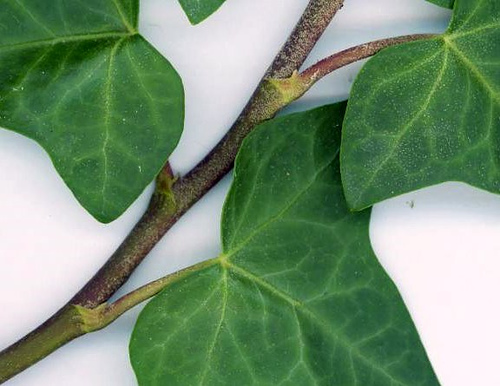


Life Cycle

English Ivy has the typical life cycle of other angiosperms. The flower on the mature adult ivy contains the ovary and the anther. These undergo meiosis and form haploid cells. Haploid cells then undergo mitosis to produce the embryonic sac and the pollen sac. Sperm from the pollen sac travels through the pollen tube of the embryonic sac to start the processes of pollination and fertilization. These processes produce the seed, which is contained in the fruit, that will be transported by birds to other soil areas for new ivy plants to grow.
Hedera helix has two different stages in its life
cycle: juvenile and adult. In the juvenile stage, the ivy
does most of its climbing. Rootlets sprout out from leaf
nodes and attach to vertical surfaces to begin the climbing
process. Leaves in this s tage
of life are dark green, waxy, and leathery. They are also
sharply lobed.
tage
of life are dark green, waxy, and leathery. They are also
sharply lobed.
In the adult phase, climbing begins to cease, and the leaves
take on a slightly different appearance. Instead of being
sharply lobed, they become smooth and rounded. Leaves also
change to a lighter shade of green because they have climbed up
closer to sunlight and need less chloroplasts to complete photosynthesis.
to sunlight and need less chloroplasts to complete photosynthesis.
As climbing comes to a halt, the adult ivy produces a woody, erect stem from the ground or the vines that it had been climbing with. Another change in the adult phase is the production of flowers and fruit. Small, pale, yellow-green flowers are produced in clusters on the ends of leaves in the fall. Shortly after that, black colored berries appear containing seeds that aid in reproduction. Birds that transport these seeds include Northern Robins, Stellar Jays, Mockingbirds, Cedar Waxwings, European Starlings, and House Sparrows.